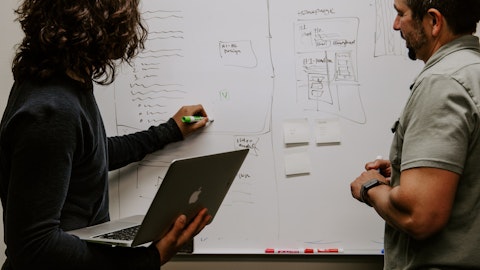So, it’s a different commodity. It has a shelf life that’s rather short than a lot of the other commodity businesses I’ve been around. And so, it’s something we manage through every year. And unfortunately, how the operating environment and the environment with this particular crop shaped up, the quality of the crop yields just put a lot of pressure on availability, which there’s plenty of potatoes around.
Robert Moskow: Got it. I guess a follow-up. I think you said on the last call that about 20% of your North American business was still in contract discussions. Is all of that done now? And did you get the pricing that you expected to get in those discussions?
Bernadette Madarieta: Yeah. So, the contract renewal process is complete now, and we feel really good about where, in the aggregate, we ended on both pricing and terms. A lot of that relates to the large chain restaurants that we typically will finalize in the back half of the year, and that’s what makes up that 20% that you’re referencing.
Robert Moskow: Great. Okay. Thank you.
Operator: We’ll now take our next question from Rob Dickerson with Jefferies.
Rob Dickerson: Great. Sorry about that. Thank you. Just a quick clarification question. I want to come back to the kind of sequential, I guess, implied gross margin trajectory for Q3. I guess it’s more for Bernadette. I think you said there are some plants that maybe were kind of being shut down kind of temporarily by implementing some of the ERP initiatives. But then, at the same time, right, Q3 is usually the highest gross margin quarter and at the same time, we’re comparing it to Q2, inclusive of the write-down, but then extra write-down or like closer to 31%. So, the very basic question with the long buildup was, if you were saying that the gross margin would be down sequentially a little bit from the normalized gross margin in Q2 once we ex out the inventory, is that how you were speaking to that?
Bernadette Madarieta: Yeah, exactly. So, I’d say it’s going to be down sequentially from the 31%, that’s excluding that write-off, and that’s really reflecting the reduced fixed cost coverage that we’re going to have as a result of taking those plants down, while we cutover.
Rob Dickerson: Got it. And then, in terms of the EBITDA margin, the same logic flows through?
Bernadette Madarieta: Absolutely.
Rob Dickerson: Okay. Cool. And then, I guess, just back to the volume piece, no change there. Still expected for volume to be down mid-single digits for the year. I remember coming out of the last call, there were some questions around that because getting like down, like real down, like mid-single digits. Seem kind of challenging if we’re thinking Q4 is up even if it’s up a little bit and now we have the first half. So, if we kind of put it all together and think, well, what about Q3, you’re still saying that kind of overall volume should improve year-over-year sequentially relative to Q2 and then Q4 is up a little bit that still gets you down to at least a 4% decline. And I’m just asking that kind of in a detailed way because it is kind of challenging to get down any more than 4%, right?
Bernadette Madarieta: Yeah. So, Rob — yeah. So, the way to look at it is, first, we’re really pleased with what we’re seeing from a volume perspective and the sequential improvement that we’ve continued to post. We will be positive in the fourth quarter, but the thing we’ve got to keep in mind is that we are having reduced shipments as a result of converting over to our new ERP. I spoke about the inventory visibility challenges that we have with our third-party warehouses. I’m confident and — that we’re correcting those, but we are going to temper our volume increases in the third quarter as a result of that.
Rob Dickerson: Okay. So, kind of in theory, like, volumes could be down in Q3, maybe in a similar way relative to Q2, hopefully a little bit better, but there are a bunch of moving pieces that we shouldn’t be expecting, like, a nice sequential improvement in Q3?
Bernadette Madarieta: That’s right.
Rob Dickerson: Okay. Cool. And then, thirdly, I just want to touch on China quickly, Tom, I think you said China is growing double digit kind of normalized, I guess, once we ex out some of the business exits. Maybe just kind of touch on kind of overall environment in China, kind of what you’re seeing, given all the news flow over the past few months? And then, maybe just if you could touch on kind of your ability, let’s say, to continue to partner with McDonald’s over the next couple of years, clearly, as they look to truly expand within the country? That’s it. Thank you.
Tom Werner: Yeah, Rob. So, as we stated earlier that China is growing at double digits. We’re well positioned. We just opened up our second factory over there. It’s up and running and operating. It gives us considerable flexibility as we’re thinking about the next year’s contracting coming up. And so, we’re — there’s a lot of news feed on China and the economy and all that’s going on. But in terms of the category, we feel good about where that’s at based on the data we look at, which is telling us it’s growing double digits. We’ve got our plant up and coming. We’ve got line of sight to how we’re going to look at that market and potential customers that we can support and more to come on that. But as we go through this contracting season in that international market, we’re well positioned to gain some business.
Bernadette Madarieta: Yeah. And then just to clarify, the double-digit growth has been in restaurant traffic that we’re seeing in China.
Rob Dickerson: All right, super. All right, that’s all. Thanks, team.
Operator: [Operator Instructions] We will now take our next question from Peter Galbo with Bank of America.
Peter Galbo: Hey, guys, good morning. Thanks for taking the question.
Bernadette Madarieta: Good morning, Pete.
Tom Werner: Good morning, Pete.
Peter Galbo: I guess, just — on the pricing front, obviously, you’re going through some contract negotiations. But if I remember correctly, you have some contracts, I think, with your global customers that actually kicked in a couple of days ago or I guess the start of Q3. So, just can you remind us kind of what the dynamic looks like there or that embed in price that we should be thinking about — price/mix that we should be thinking about in the back half of the year?





